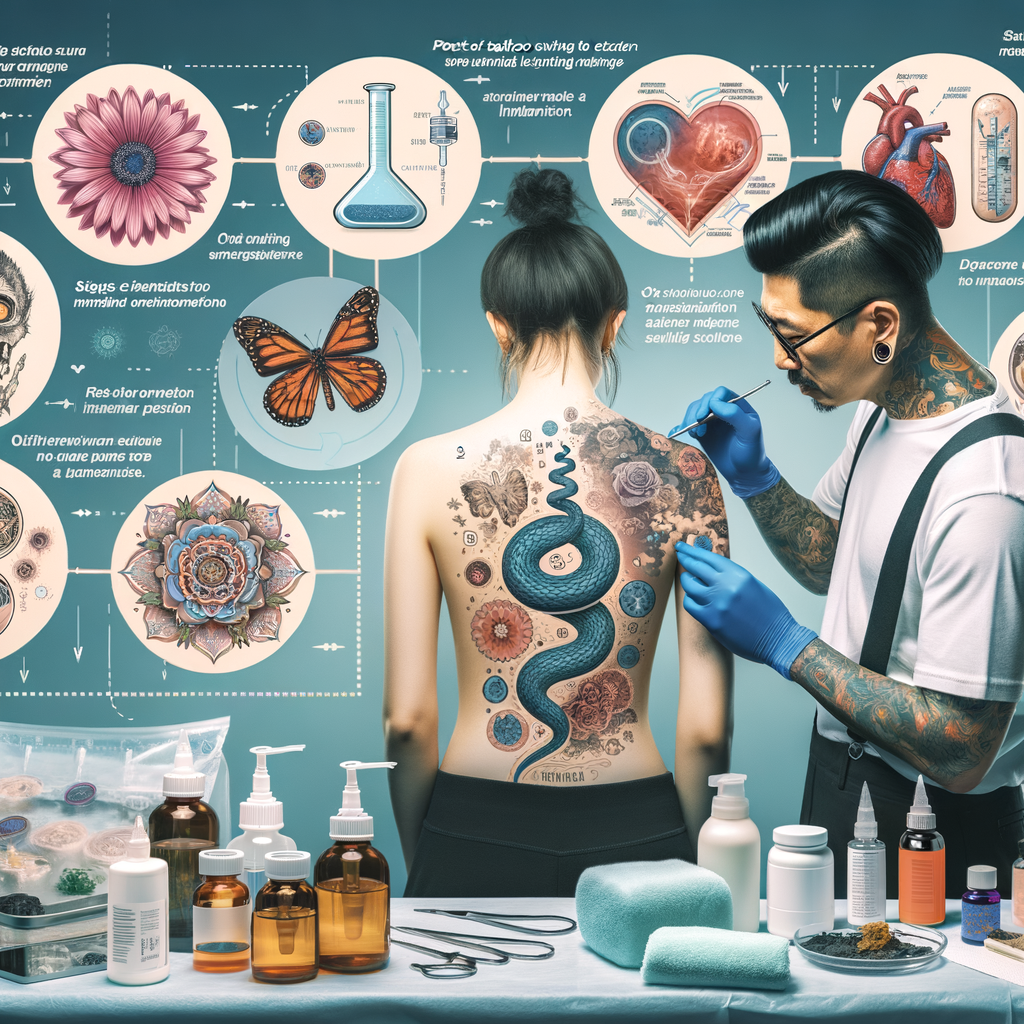
Introduction to Tattoo Aftercare
Getting a tattoo is an exciting experience, but it’s only the first step in a longer process. After the tattoo is done, the real work begins – taking care of your new piece of body art. This is called tattoo aftercare, and it’s crucial for maintaining the quality and longevity of your tattoo.
-
- Importance of Tattoo Aftercare
Tattoo aftercare is not something to be taken lightly. It’s a critical part of the tattooing process that can significantly impact the final result. A well-cared-for tattoo will heal properly, maintain its vibrant colors, and last longer. On the other hand, neglecting aftercare can lead to complications such as infection, color fading, and even permanent damage to your skin.
-
- Common Issues in Tattoo Healing Process
During the healing process, you may encounter a few common issues. These include swelling, redness, itching, and scabbing. While these are normal to some extent, excessive or prolonged symptoms can indicate a problem. Other issues like infection, allergic reactions, or tattoo blowout (when the ink spreads under the skin) can occur if the tattoo is not properly cared for. Understanding these issues can help you identify them early and take appropriate action.
Remember, your tattoo is a permanent addition to your body. It’s worth investing the time and effort into proper aftercare to ensure it heals well and looks great for years to come. In the following sections, we will delve deeper into specific aftercare tips, understanding and managing swelling, and post-tattoo care.
Tattoo Aftercare Tips
Getting a tattoo is an exciting experience, but the real challenge begins after you leave the tattoo studio. Proper aftercare is crucial to prevent infection and ensure your tattoo heals nicely. Here are some immediate aftercare tips for new tattoos.
Immediate Aftercare for New Tattoos
Following a few simple steps can make a big difference in how your tattoo heals. Let’s go through these steps one by one.
-
- Removing the bandage
Your tattoo artist will cover your new tattoo with a bandage to protect it from bacteria. It’s important to leave this bandage on for at least a few hours, but no longer than 24 hours. When it’s time to remove the bandage, do so gently to avoid irritating your skin.
-
- Cleaning the tattoo
Once you’ve removed the bandage, it’s time to clean your tattoo. Use lukewarm water and a mild, unscented soap to gently wash away any blood or plasma. Avoid using a washcloth or anything abrasive. Instead, use your hands to carefully clean the area. Rinse thoroughly and pat dry with a clean towel.
-
- Applying ointment
After cleaning your tattoo, apply a thin layer of a specialized tattoo aftercare ointment or a fragrance-free moisturizer. This helps to keep your skin hydrated and promotes healing. Remember, less is more when it comes to ointment. Too much can suffocate your skin and lead to issues like pimples.
These immediate aftercare steps are crucial for the healing process of your new tattoo. Remember, everyone’s skin heals at different rates, so be patient and give your body the time it needs to heal.
Long-Term Tattoo Aftercare
Once your tattoo has healed, it’s essential to maintain its health and vibrancy with long-term aftercare. Here are some key steps you should follow:
- Moisturizing the Tattoo
Keeping your tattoo moisturized is crucial for maintaining its color and preventing skin dryness. Use a fragrance-free, hypoallergenic lotion or a specialized tattoo moisturizer. Apply a thin layer once or twice a day, depending on your skin type. Remember, over-moisturizing can lead to clogged pores and breakouts, so moderation is key.
- Protecting the Tattoo from Sun Exposure
Excessive sun exposure can fade your tattoo and damage your skin. Always apply a high SPF sunscreen on your tattooed skin before stepping out in the sun. Consider wearing clothing that covers your tattoo when you’re outside for extended periods. Remember, even on cloudy days, UV rays can still reach your skin, so don’t skip the sunscreen.
- Avoiding Scratching and Peeling
It’s natural for a healed tattoo to occasionally peel or become itchy, especially during seasonal changes. However, scratching can damage the tattoo and your skin. Instead, apply a moisturizer to soothe the itch. If peeling occurs, don’t pick at it. Let it come off naturally to avoid disturbing the tattoo’s appearance.
In conclusion, long-term tattoo aftercare is a commitment. By moisturizing regularly, protecting from sun exposure, and avoiding scratching and peeling, you can keep your tattoo looking vibrant and healthy for years to come.
Understanding Tattoo Swelling
When you get a tattoo, your skin undergoes a process. It’s normal for your tattoo to swell a bit. But, it’s important to understand why it happens and how to tell if it’s a normal part of healing or a sign of infection. Let’s dive into it.
- Causes of Tattoo Swelling
Tattoo swelling is a common response of your body to the tattooing process. When a needle punctures your skin repeatedly, it causes a sort of injury. Your body responds by sending more blood to the area to help heal it. This increased blood flow can cause the area to swell.
Other factors can also contribute to tattoo swelling. These include the location of the tattoo, the size and complexity of the design, and your body’s individual response to injury. For example, tattoos on areas like the ankles or feet often swell more because these areas have less muscle and fat to cushion the impact of the needle.
- Differentiating Normal Swelling from Infection
While some swelling is normal after getting a tattoo, it’s crucial to know the difference between normal swelling and signs of an infection. Normal swelling usually subsides within a few days and is accompanied by redness and a little discomfort. However, if the swelling continues to increase after a few days, or if it’s accompanied by severe pain, heat, or pus, it could be a sign of infection.
Here’s a simple table to help you differentiate between normal swelling and infection:
| Normal Swelling | Infection | |
|---|---|---|
| Duration | A few days | More than a week |
| Accompanied by | Redness, slight discomfort | Severe pain, heat, pus |
If you suspect an infection, it’s important to seek medical attention immediately. An untreated infection can lead to serious complications and may even damage your tattoo.
Reducing Tattoo Inflammation
After getting a tattoo, it’s normal to experience some swelling and inflammation. This is a sign that your body is healing. However, too much inflammation can cause discomfort and delay the healing process. Here are some effective methods to reduce tattoo inflammation.
Swelling Reduction Methods
There are several methods to reduce swelling after getting a tattoo. Let’s explore them one by one.
-
- Elevation
Elevating the tattooed area can help reduce swelling. This method works by using gravity to drain excess fluid away from the inflamed area. For example, if you have a tattoo on your arm, try to keep it elevated above your heart level as much as possible.
-
- Ice Application
Applying ice to the swollen area can also help reduce inflammation. The cold temperature constricts blood vessels, which can reduce swelling and numb pain. Remember to wrap the ice in a cloth before applying it to your skin to avoid frostbite.
-
- Use of Over-The-Counter Anti-Inflammatory Drugs
Over-the-counter anti-inflammatory drugs, like ibuprofen, can help reduce swelling and pain. These drugs work by blocking the body’s production of substances that cause inflammation. However, always follow the instructions on the label and consult your doctor if you have any health conditions that may prevent you from taking these medications.
Remember, everyone’s body reacts differently to tattoos. What works for one person might not work for another. It’s important to listen to your body and consult a healthcare professional if your inflammation doesn’t reduce after a few days or if it gets worse.
Tattoo Swelling Remedies
When you get a new tattoo, it’s normal to experience some swelling. This is your body’s natural response to the ink being injected into your skin. However, too much swelling can be uncomfortable and may even affect the healing process of your tattoo. Thankfully, there are several remedies you can use to help reduce swelling. These remedies fall into two main categories: natural remedies and medical treatments.
-
- Natural Remedies
Natural remedies are simple, easy-to-use solutions that you can often find in your own home. They can be very effective in reducing swelling and promoting healing.
-
-
- Ice Packs: Applying an ice pack to your swollen tattoo can help reduce inflammation. Remember to wrap the ice pack in a cloth before applying it to your skin to avoid frostbite.
- Elevation: Elevating the tattooed area above the level of your heart can help reduce swelling by encouraging blood flow away from the area.
- Hydration: Drinking plenty of water can also help reduce swelling. Water helps flush toxins out of your body, which can speed up the healing process.
- Medical Treatments
-
If natural remedies aren’t enough to reduce your tattoo swelling, you may want to consider medical treatments. Always consult with a healthcare professional before starting any new medication.
-
- Over-the-counter anti-inflammatory drugs: Non-prescription drugs like ibuprofen can help reduce swelling and pain. However, it’s important to follow the instructions on the package and not exceed the recommended dosage.
- Prescription medication: In some cases, your doctor may prescribe a stronger anti-inflammatory medication to help manage your swelling. Always take your medication as directed by your doctor.
Remember, everyone’s body reacts differently to tattoos. What works for one person may not work for another. It’s important to listen to your body and give it the care it needs to heal properly. If your swelling continues or gets worse, don’t hesitate to seek medical attention.
Managing Tattoo Swelling
Swelling is a common reaction after getting a tattoo. It’s part of your body’s natural healing process. However, it’s important to know when swelling is normal and when it’s a sign of something more serious. In this section, we’ll discuss when to seek medical help and how to prevent further complications.
-
- When to seek medical help
While it’s normal for a new tattoo to be a bit swollen, there are signs you should watch out for that may indicate a problem. If your tattoo is extremely swollen, or if the swelling doesn’t go down after a few days, it might be time to seek medical help. Other signs of trouble include severe pain, red streaks radiating from the tattoo, a high fever, or pus coming from the tattoo. These could be signs of an infection, which requires immediate medical attention.
-
- Preventing further complications
Preventing complications starts with good tattoo aftercare. Always clean your tattoo with mild soap and warm water, then apply a thin layer of a recommended moisturizer. Avoid scratching or picking at the tattoo, as this can introduce bacteria and cause an infection. It’s also important to protect your tattoo from the sun, as sun exposure can cause the tattoo to fade and increase the risk of skin damage. Lastly, stay hydrated and maintain a healthy diet to support your body’s healing process.
Remember, every person’s body reacts differently to tattoos. What’s normal for one person may not be normal for another. When in doubt, it’s always best to consult a healthcare professional. They can provide guidance based on your specific situation and help ensure your tattoo heals properly.
Post-Tattoo Care
After getting a tattoo, it’s essential to take proper care of it. This not only ensures that your tattoo heals correctly, but also helps maintain its vibrant colors and sharp lines. One common issue people face after getting a tattoo is swelling. Let’s discuss how to reduce swelling and the importance of continued care and follow-up appointments.
How to Reduce Swelling
Swelling is a normal part of the healing process after getting a tattoo. However, excessive swelling can cause discomfort and potentially affect the appearance of your tattoo. Here are two key steps to reduce swelling and ensure proper healing:
-
- Continued Care
Continued care is crucial in the days and weeks following your tattoo session. This includes cleaning the tattoo gently with mild soap and water, applying a thin layer of recommended ointment, and avoiding scratching or picking at the tattoo. It’s also important to keep the tattoo out of direct sunlight and avoid submerging it in water. These steps can help reduce swelling and prevent infection.
-
- Importance of Follow-Up Appointments
Follow-up appointments with your tattoo artist are a vital part of post-tattoo care. During these appointments, your artist can check on the healing process, address any concerns you may have, and provide additional care if needed. Regular follow-ups can help manage swelling and ensure your tattoo heals properly.
Remember, every person’s body reacts differently to tattoos. What works for one person may not work for another. Therefore, it’s essential to listen to your body and follow the advice of your tattoo artist.
Tattoo Aftercare Swelling: Case Studies
Understanding the importance of proper tattoo aftercare, particularly in managing swelling, can be best illustrated through real-life case studies. Here, we will discuss two cases that highlight the significance of proper care and the potential complications that can arise from neglect.
-
- Case study 1: Successful swelling management
John, a 25-year-old man, got his first tattoo. He followed the aftercare instructions provided by his tattoo artist diligently. He kept the tattoo clean, applied the recommended ointment regularly, and avoided scratching the area. He also took care to avoid sun exposure and swimming. Despite experiencing some swelling, which is a normal part of the healing process, John managed it successfully by applying a cold compress and elevating the tattooed area. His tattoo healed beautifully without any complications, demonstrating the effectiveness of proper aftercare.
-
- Case study 2: Complications due to neglect
On the other hand, we have Sarah, a 30-year-old woman who also got her first tattoo. Unlike John, Sarah did not follow the aftercare instructions. She neglected to clean the tattooed area and frequently scratched it due to the itchiness. She also exposed her tattoo to the sun and went swimming before it was fully healed. As a result, her tattooed area swelled significantly and became infected. Sarah had to seek medical attention and her healing process was prolonged. This case highlights the potential complications that can arise from neglecting proper tattoo aftercare.
These case studies underscore the importance of following the recommended tattoo aftercare instructions. Proper care can lead to successful healing, while neglect can result in complications such as excessive swelling and infection. Remember, taking care of your tattoo is an essential part of the tattooing process. It’s not just about getting a tattoo; it’s about keeping it looking great for years to come.
Conclusion: Key Takeaways in Tattoo Aftercare
As we wrap up this comprehensive guide on tattoo aftercare, let’s summarize the key points that you should remember. These points are not only crucial for maintaining the vibrancy of your tattoo but also for your overall health and well-being.
-
- Importance of Proper Aftercare
Proper aftercare is the cornerstone of a healthy and vibrant tattoo. It helps to preserve the quality of the artwork and prevents any potential infections. Remember, a tattoo is a wound on your skin, and like any other wound, it needs to be taken care of properly. This includes keeping the tattoo clean, moisturizing it regularly, and protecting it from the sun.
-
- Effective Methods to Reduce Swelling
Swelling is a common occurrence after getting a tattoo. However, it can be effectively managed by using cold compresses, elevating the tattooed area, and taking over-the-counter anti-inflammatory medications. Remember, excessive swelling may be a sign of infection, so if the swelling does not reduce after a few days, it’s best to consult a healthcare professional.
-
- Recognizing Signs of Complications
While tattoos are generally safe, complications can occur. It’s important to recognize the signs of potential complications such as excessive redness, swelling, pus, or severe pain. If you notice any of these signs, it’s crucial to seek medical attention immediately. Your health should always be your top priority.
In conclusion, tattoo aftercare is a crucial part of the tattoo process. It not only ensures the longevity and vibrancy of your tattoo but also helps to prevent any potential health complications. So, take these key points to heart and ensure that your tattoo remains a source of joy and pride for years to come.






